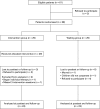Parent based language intervention for 2-year-old children with specific expressive language delay: a randomised controlled trial
- PMID: 18703544
- PMCID: PMC2614563
- DOI: 10.1136/adc.2008.141572
Parent based language intervention for 2-year-old children with specific expressive language delay: a randomised controlled trial
Abstract
Objective: The aim of this randomised controlled trial was to evaluate the effectiveness of a short, highly structured parent based language intervention group programme for 2-year-old children with specific expressive language delay (SELD, without deficits in receptive language).
Methods: 61 children with SELD (mean age 24.7 months, SD 0.9) were selected between October 2003 and February 2006 during routine developmental check-ups in general paediatric practices, using a German parent-report screening questionnaire (adapted from the MacArthur Communicative Development Inventories). Standardised instruments were used to assess the language and non-verbal cognitive abilities of these children and of 36 other children with normal language development (reference group; mean age 24.6 months, SD 0.8). 58 children with SELD were sequentially randomly assigned to an intervention group (n = 29) or a 12-month waiting group (n = 29). In the intervention group, mothers participated in the 3-month Heidelberg Parent-based Language Intervention (HPLI). All children were reassessed 6 and 12 months after pretest. Assessors were blind to allocation and previous results.
Results: 47 children were included in the analysis. At the age of 3 years, 75% of the children in the intervention group showed normal expressive language abilities in contrast to 44% in the waiting group. Only 8% of the children in the intervention group versus 26% in the waiting group met the criteria for specific language impairment (t score < or =35).
Conclusions: By applying the short, highly structured HPLI in children with SELD, the rate of treatment for language impairment at the age of 3 years can be significantly reduced.
Conflict of interest statement
Figures
Comment in
-
Wayward words and watchful waiting: should clinicians be more proactive for the preschooler with uncomplicated expressive language delay?Arch Dis Child. 2009 Feb;94(2):80-2. doi: 10.1136/adc.2008.148528. Arch Dis Child. 2009. PMID: 19158135 Review. No abstract available.
-
Parent-based language intervention for 2-year old children with specific expressive language delay: a randomised controlled trial with erroneous confidence (intervals).Arch Dis Child. 2010 Nov;95(11):953. doi: 10.1136/adc.2009.167346. Epub 2010 Sep 29. Arch Dis Child. 2010. PMID: 20880946 No abstract available.
Similar articles
-
Parent-implemented early language intervention programme for late talkers: parental communicative behaviour change and child language outcomes at 3 and 4 years of age.Int J Lang Commun Disord. 2019 May;54(3):451-464. doi: 10.1111/1460-6984.12451. Epub 2019 Jan 24. Int J Lang Commun Disord. 2019. PMID: 30680870 Clinical Trial.
-
Children with developmental language delay at 24 months of age: results of a diagnostic work-up.Dev Med Child Neurol. 2008 Mar;50(3):223-9. doi: 10.1111/j.1469-8749.2008.02034.x. Epub 2008 Feb 11. Dev Med Child Neurol. 2008. PMID: 18266869
-
Markers for persistent specific expressive language delay in 3-4-year-olds.Int J Lang Commun Disord. 2013 Sep-Oct;48(5):534-53. doi: 10.1111/1460-6984.12028. Epub 2013 Jul 25. Int J Lang Commun Disord. 2013. PMID: 24033652
-
Responsive parenting intervention after identification of hearing loss by Universal Newborn Hearing Screening: the concept of the Muenster Parental Programme.Int J Pediatr Otorhinolaryngol. 2013 Dec;77(12):2030-9. doi: 10.1016/j.ijporl.2013.10.002. Epub 2013 Oct 12. Int J Pediatr Otorhinolaryngol. 2013. PMID: 24182601 Review.
-
A review of recommendations for sequencing receptive and expressive language instruction.J Appl Behav Anal. 2011 Winter;44(4):859-76. doi: 10.1901/jaba.2011.44-859. J Appl Behav Anal. 2011. PMID: 22219535 Free PMC article. Review.
Cited by
-
Identifying Language Disorder Within a Migration Context: Development and Performance of a Pre-school Screening Tool for Children With German as a Second Language.Front Pediatr. 2022 Mar 8;10:814415. doi: 10.3389/fped.2022.814415. eCollection 2022. Front Pediatr. 2022. PMID: 35345610 Free PMC article.
-
A Parent-Implemented Language Intervention for Late Talkers: An Exploratory Study on Low-Risk Preterm and Full-Term Children.Int J Environ Res Public Health. 2020 Dec 7;17(23):9123. doi: 10.3390/ijerph17239123. Int J Environ Res Public Health. 2020. PMID: 33297374 Free PMC article. Clinical Trial.
-
Clinical practice guideline: Interventions for Developmental Language Delay and Disorders.Dtsch Arztebl Int. 2024 Mar 8;121(5):155-162. doi: 10.3238/arztebl.m2024.0004. Dtsch Arztebl Int. 2024. PMID: 38377329 Free PMC article.
-
Examining the effectiveness of a video-based parent-child program on executive functions for children 5 to 6 years old: A randomized controlled trial.Child Dev. 2025 Mar-Apr;96(2):781-796. doi: 10.1111/cdev.14208. Epub 2024 Dec 12. Child Dev. 2025. PMID: 39665508 Free PMC article. Clinical Trial.
-
Association of Parent Training With Child Language Development: A Systematic Review and Meta-analysis.JAMA Pediatr. 2019 Jul 1;173(7):671-680. doi: 10.1001/jamapediatrics.2019.1197. JAMA Pediatr. 2019. PMID: 31107508 Free PMC article.
References
-
- Horwitz SM, Irwin JR, Briggs-Gowan M, et al. Language delay in a community cohort of young children. J Am Acad Child Adolesc Psychiatry 2003;42:932–40 - PubMed
-
- Reilly S, Wake M, Bavin EL, et al. Predicting language at 2 years of age: a prospective community study. Pediatrics 2007;120:1441–9 - PubMed
-
- Buschmann A, Jooss B, Rupp A, et al. Children with developmental language delay at 24 months of age: results of a diagnostic work-up. Dev Med Child Neurol 2008;50:223–9 - PubMed
-
- Paul R. Predicting outcomes of early expressive language delay: ethical implications. Bishop D V M, Leonard L B, eds. Speech and language impairments in children: causes, characteristics, intervention and outcome East Sussex, UK: Psychology Press, 2000:195–209
-
- Deutsche Gesellschaft für Kinder- und Jugendpsychiatrie und Psychotherapie (Hrsg) Leitlinien zur Diagnostik und Therapie von psychischen Störungen im Säuglings-, Kindes- und Jugendalter 3.überarbeitete Auflage.Cologne: Deutscher Ärzte Verlag, 2007:197–206
Publication types
MeSH terms
LinkOut - more resources
Full Text Sources
Medical
Miscellaneous


